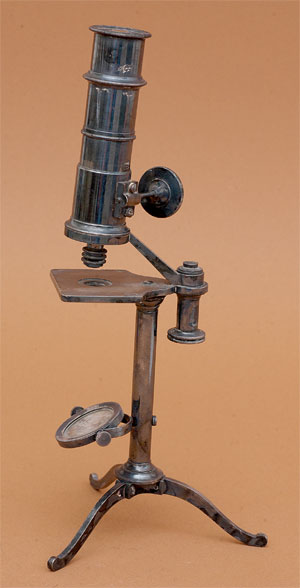This instrument is a small compound microscope made from silver-plated brass. The microscope is supported by a single round pillar and three folding tripod legs. Just above the legs is a hole that accommodates the pin support for the gimbaled mirror. A plate is riveted to the top of the support pillar. The front of the plate forms the sample stage, and the back of the plate is the support for the microscope pivot mechanism for aquatic observation. The stage has two small holes at the back for mounting stage clips, now missing. The microscope is supported by an angled limb and a sleeve that screws into the limb. When inserted into the sleeve, pinion threads line to with a cutout in the sleeve and mates with the pinion focusing shaft. A knurled thumbscrew (22mm diameter) turns the shaft and focuses the sample. The microscope has optics typical of the early to mid 18th Century. The objectives consist of two or more single lenses (usually plano-concave) screwed together. These lens casettes then screw into the threaded snout. The field lens is mounted in the center of the body tube, and the single plano-convex eye lens is mounted to the top of the eyepiece. Using the existing mounted lens the magnification is approximately 75x. Imaging is good, except for poor contrast due to the absence of a condenser. Two additional brass objectives and their fish skin covered carrying case are the only accessories with this instrument. Total height is 23.5cm.
The shape of the support legs, and the muti-lens objective suggest that this microscope was made in France c1800.
Microscope featured 06/2015






